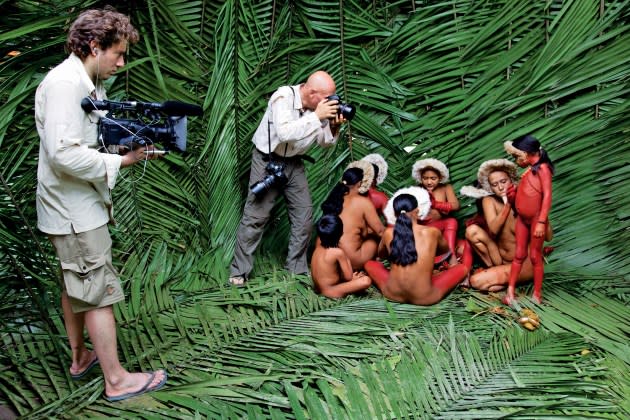Inside the Doc on Sebastiao Salgado’s Amazing Life in Pictures
- Oops!Something went wrong.Please try again later.
- Oops!Something went wrong.Please try again later.

The first time Wim Wenders saw Brazilian photographer Sebastião Salgado’s work — a haunting black and white portrait of workers toiling in the Amazon’s Serra Pelada gold mine — he bought the print on the spot. Soon, he began collecting the artist’s pictures, chasing down stills for sale and picking up books of the artist’s work wherever he could find them. “Whenever I was asked in interviews who my favorite photographer was,” the 69-year-old German filmmaker says, “I would tell people about Sebastião. He’s able to create bonds with people by investing more than other photographers. He doesn’t stay a day or two and get the heck out of there. He stays, and comes back a year later. He realizes these people expect him to come back, because they’ve become friends.”
After years of admiring Salgado’s portraits of exiles, ecological disasters, and various indigenous communities (many shots of which have appeared in Rolling Stone‘s pages), Wenders decided he wanted to meet the man himself. “I was always just missing him when I’d go to his exhibits,” he says. “Luckily, I knew a gallery owner in Italy who’d shown his work, so I asked him, ‘Do you know where I can find him?'” Showing up on Salgado’s doorstep in Paris in 2009, the director and the photographer bonded over their mutual love of soccer. Later, when Sebastião, 71, and his son, Juliano, 41, asked for advice about doing a big-screen presentation, Wenders told the elder shutterbug, “Don’t do a slideshow. You have all these great stories, tell them alongside your photos. ‘Well, I have to tell them to somebody,’ he said. Then father and son looked right at me… .” The filmmaker laughs loudly and shrugs. “I had talked myself into doing it.”
More from Rolling Stone
Celine Dion's Career and Health Battle Will Be Subject of New Documentary
Lil Nas X's Tour Documentary Doesn't Pretend to Be Something It's Not
The result, The Salt of the Earth, charts the photographer’s career from his early days as an expat economist living in France (where he first picked up a camera as a lark) to shooting photo-essays on the civil war in Rwanda and migrant workers forced to leave their families and homes. What emerges is a thought-provoking study on the intersection of journalism and humanitarian commitment, as the Wings of Desire filmmaker allows the septuagenarian artist to speak over superimposed shots of his work and reflect on decades of bearing witness to the world’s suffering.

But with Juliano signing on as a co-director, the documentary also incorporates earlier, personal footage shot by the younger Salgado as he accompanied his father on several assignments — an experience that finally allowed him to get to know his long-absent dad. When the two men first tried to integrate both of their work together, however, the attempt was a bit of a disaster.
“Initially, I had my editor, and he had his editor,” Wenders says, gesturing to his collaborator sitting across from him. “We’d be sitting across from each other, putting together our own versions and constantly threatening to cut each other’s stuff out!” Juliano picks up the thread: “Wim and I were each doing our own separate movies, essentially, and neither of them were working. Eventually, we realized that he and I both needed what the other had — and so we had sit together at one editing station and put it all together.”
“We were on our own paths,” Wenders admits. “We needed it to make it a single journey — something objective and personal.”
Ultimately, as Sebastião comments on a lifetime’s worth of work and speaks openly about how his “Genesis” project of documenting untouched landscapes helped pull him out of a downward spiral, The Salt of the Earth combines these two strands in a way that deeply affected all three participants. “I finally felt I knew who my dad is,” Juliano admits, while Wenders says “I’ve been looking at these photographs for 20 years. And it wasn’t until I saw the film that I felt I finally saw them for the first time.”
Best of Rolling Stone

